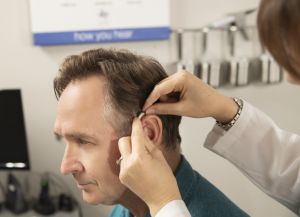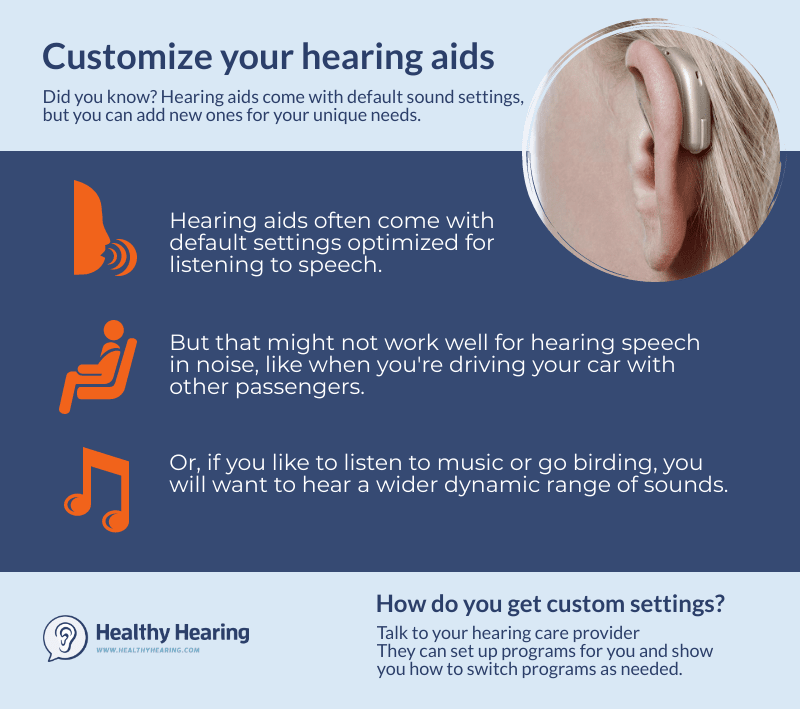If hearing aids are recommended after your hearing is tested, your hearing care professional will work with you to find the right hearing aids for you. That selection process, called a hearing aid fitting, starts with an assessment of your needs and ends with follow-up visits after the customized programming of your devices.
Table of Contents
Assessment of hearing aid needs

proper hearing aid selection is important.
Your hearing care professional will begin the selection process by conducting an in-depth consultation with you to learn more about your lifestyle, your expectations, your personal preferences and your thoughts on any previous experiences with hearing aids. Your hearing test results, along with this information, will help the professional pull together some options for you to review.
Hearing test results
Your hearing test will produce an audiogram that will help you and your hearing care professional pick the best hearing aid style for you. The degree of your hearing loss will determine which styles may work best for you, with smaller models generally suited for milder hearing loss. If you’ve never worn hearing aids before, this primer on types and styles of hearing aids may be useful.
What are your lifestyle needs?
When considering your hearing aid, it is important for the professional to get a picture of the lifestyle you desire. You may have gradually avoided certain environments and social situations as your hearing loss worsened. Now is the time to think about what you’d like to be able to do with the help of your new hearing aids! For example, if you spend your evenings talking on to family and friends on the phone, you’ll want a hearing aid that works well with your phone. If you work in a busy office, a hearing aid and assistive listening devices may be recommended to make group conversations easier.
Generally, more advanced digital hearing aids are designed for people who encounter many different listening situations with varying degrees of background noise. For sedentary people who are mostly at home with little background noise, basic models may be recommended. (Keep in mind that if mobility or traveling is a problem, seeing an audiologist using telehealth may be an option.)
What are your preferences?
There are many different types of preferences that can affect hearing aid selection. Do you want hearing aids that are nearly invisible, or would you rather have something large enough that allows you to pick a bright color and show off your style? Do you prefer to have control over the volume of your aids or would you prefer to have automated technology that changes it for you? Do you want gadgets, like remote controls and wireless accessories for your hearing aids?
Your preferences may be affected by your level of manual dexterity, especially when it comes to selecting your preferred style of hearing aid batteries. Do you prefer rechargeable batteries that you dock each night? If not, will you be willing and able to change a small battery every few days to weeks? These are just a few of the preferences that the hearing care professional will explore with you.
Have you worn hearing aids before?
Finally, it’s important to consider any prior hearing aid experience when selecting a new hearing aid. Did you love your last set of hearing aids? Why? Did you like the style, the sound quality or something else? What did you have difficulty hearing with your old hearing aids? What new features would you like to try? This type of insight will help your hearing professional determine what you will need in your new hearing instruments to maintain—or improve—your level of satisfaction.
Should I get one or two hearing aids?
Hearing aid selection
After you’ve discussed your needs with your hearing care professional, you will generally be presented with a few recommended options at different price points. In some cases, you might have the opportunity to wear a demonstration hearing aid for a few hours or a few days to try out. Once you’ve made your decision, the hearing care professional will order your selection and schedule you to come back at a later date for the initial hearing aid programming. If you’ve decided on a custom-fit ITE style or a BTE with earmold style, your hearing care professional will take an impression of your ear canal to send in with the order.
Initial hearing aid programming

confidence to enjoy lively conversations
again.
When your hearing aid arrives at the hearing center, the hearing care professional will hook it up to the computer and calibrate it according to your hearing loss and preferences. Some professionals choose to do the programming before you arrive and some prefer to do it while you’re there.
Adjusting to hearing aids
Once the hearing aids are out of the box and in your ears, you’ll start hearing lots of things you haven’t heard for years. In fact, you might feel like everything is too loud at first. It will take time for your brain to relearn which sounds to ignore, like the sound of your own footsteps or the rustle of your clothing. But don’t worry—your hearing care professional will do some tests to make sure that the hearing aid is set appropriately for your hearing loss. You will also be counseled on how to change the battery, use any features, clean and take care of your hearing aid. Here’s more on understanding the various parts of a hearing aid.
Adjusting to hearing aids takes time. Some people only need a day or two but most people need a few weeks to a few months to adjust to using hearing aids. The important thing to remember is to wear them, even if just for a few hours the first day, an hour longer the following day, and so on until you are wearing hearing aids all day.
More: 7 tips for getting used to your new hearing aids
Adding custom hearing aid settings
The “default” setting for most hearing aids is focused on picking up speech in quiet environments. But out in the real world, sound is a lot more complex, particularly if you’re a musician or work in a noisy environment. Fortunately, your hearing care provider can add custom hearing aid settings for you, including music settings.

Successful hearing aid fittings are as individual as you are. The right hearing care provider will take the time to understand your specific needs and tailor an approach that will get the best results. Use our consumer-reviewed directory to find providers and hearing aids near you.

